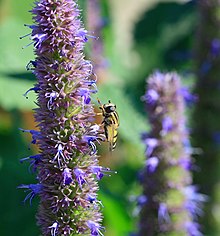Agastache
| Agastache | |
|---|---|
 |
|
| Agastache hybrid 'Blue Fortune' | |
| Scientific classification | |
| Kingdom: | Plantae |
| (unranked): | Angiosperms |
| (unranked): | Eudicots |
| (unranked): | Asterids |
| Order: | Lamiales |
| Family: | Lamiaceae |
| Subfamily: | Nepetoideae |
| Genus: |
Agastache Gronov. |
| Diversity | |
| 22 species | |
| Synonyms | |
|
Brittonastrum Briq. |
|
Brittonastrum Briq.
Flessera Adans.
Dekinia M.Martens & Galeotti
Lophanthus Benth. non Adans.: preoccupied
Agastache is a genus of aromatic flowering herbaceous perennial plants in the family Lamiaceae. It contains 22 species native to eastern Asia (one species) and North America (the rest). The common names of the species are a variety of fairly ambiguous and confusing "hyssops" and "mints"; as a whole the genus is known as giant hyssops or hummingbird mints.
Most species are very upright, 0.5–3 m tall, with stiff, angular stems clothed in toothed-edged, lance shaped leaves ranging from 1–15 cm long and 0.5–11 cm broad depending on the species. Upright spikes of tubular, two-lipped flowers develop at the stem tips in summer. The flowers are usually white, pink, mauve, or purple, with the bracts that back the flowers being of the same or a slightly contrasting color.
"Agastache" is Greek for "many spikes". The genus was established in 1762 by Jan Frederik Gronovius in the second edition of his controversial Flora Virginica, based on the specimens and notes of John Clayton. It is a member of subfamily Nepetoideae, which contains a large proportion of the world's aromatic culinary herbs. Within its subfamily, it belongs to the mint tribe (Mentheae), and therein to the catmint subtribe (Nepetinae). The Nepetinae are robustly supported by cladistic analyses of morphological and DNA sequence data, and were recognized in the mid-late 19th century already.
...
Wikipedia
